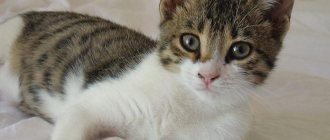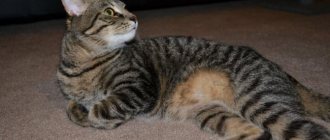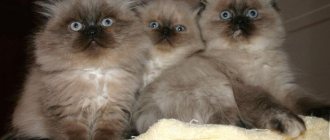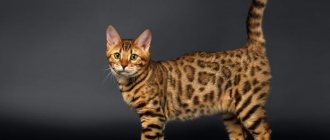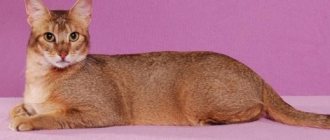The Asian tabby is the most variegated representative of the Asian group of cats. These royal-looking individuals are sedate and wise. They are not capricious either when choosing food or during hygiene procedures. One look at the cat's smart face will be enough to understand that this is an ideal pet. Asian tabby cat kind and sociable, but this is by no means a meek, weak kitty. She is not aggressive or vindictive, but can stand up for herself. He is friends with everyone - both people and animals.
Origin story
This breed appeared as a result of many years of painstaking work by breeders who set themselves the goal of breeding a new breed, as regal and beautiful as Abyssinian cats, but more hardy and physically strong, with an easy-going and friendly character.
Three breeds were chosen for the experiment: the water-loving Abyssinian, the muscular Burmese and the Persian chinchilla with long and white hair. The work was successful: the Asian tabby turned out to be exactly what felinologists dreamed of - muscular, but graceful and agile, agile, but graceful, with a sense of self-esteem, but affectionate and gentle.
The first litter of kittens appeared in 1982, and the breed received recognition after 8 long years: world felinological organizations (CCCA, WCF, GCCF, LOOF) recognized Asian tabbies as a separate breed.
Systematic breeding work with the breed initially led to the production of 3 color options: silver, dark brown and plain. But a little later there were much more of them and now every tabby lover can choose a pet to their liking.
Asian Shorthair (Malayan)
Asian Shorthair (Malay) history of the breed: When developing the Burmese breed, Siamese cats and cats of some other breeds were initially used, as a result, kittens of the wrong colors (red, cream and tortoiseshell sepia) sometimes appear in Burmese litters. Also, in the process of breeding Burmillas, monochromatic kittens appeared. These two types of cats are registered as Malayan or Asian Shorthair. Moreover, since in the USA and Europe different colors are recognized for Burmese, different cats are called Malays on different sides of the ocean. In the USA, this definition includes both solid-colored individuals and individuals of unrecognized Burmese variations (red, cream, tortoiseshell); and in Europe there are only cats of solid and tortoiseshell colors.
This breed is officially recognized in South Africa (SACC) and Britain (GCCF).
Asian Shorthair (Malay) personality: Malays are brave, affectionate and loud.
Standards
Like all cats from the Asian group, tabbies are distinguished by a flexible and slender body, and outwardly they appear deceptively fragile and light. However, when you pick up a cat, you will immediately feel how heavy it is, how powerful its pelvis is and how strong its paws are. Males always grow larger than females. The average weight of a cat is 7-8 kg, a cat is 4-5 kg.
| Standard | Description |
| Head | Elongated, with prominent cheekbones and a narrow chin. Both the chin and lower jaw are massive. |
| Eyes | Slightly oblique, almond-shaped. The iris can be yellow or amber in color. |
| Nose | Wide, medium length, with a smooth transition to the forehead. |
| Ears | Medium size, straight set, their tips are rounded. Slightly tilted forward. The presence of small tassels is not considered a violation. |
| Torso | Sleek yet muscular. The chest is quite wide, the back is strong, the pelvis is massive, but not heavy. |
| Paws | Slender, moderately long, proportional to the body. The pads are oval and neat. |
| Tail | Medium length, straight, without loops or bends. Tapers towards the tip. Regardless of color, it should be darker than the rest of the body. |
| Wool | Short, velvety, shimmers beautifully in the sun. There is no undercoat. The hairs are colored in 2 tones: the colors softly blend into one another, which creates a variegated effect for any color. A distinctive feature of Asian tabbies is the clearly visible “scarab mark” on the forehead. |
Australian Tiffany
Australian Tiffany breed history: Australian Tiffany is the result of the work of Australian felinologists who decided in the 90s. XX century deal with Burmilla kittens with long hair. Since long-haired Asian cats in solid and tortoiseshell colors had already been bred and called Tiffanys, Australians focused on silver and golden animals. These cats became especially popular in the state of New South Wales, where they were first recognized by the local association. In fact, Australian Tiffanys are semi-longhaired Burmilla and Burmoire dogs. However, the Australian Tiffany is distinguished from both of them by a wider head and a more pronounced stop, which makes the latter similar to the American Burmese.
In 1999 the new breed was recognized by the Australian show system.
Australian Tiffany character: Australian Tiffanys are not very active, but they are friendly and unobtrusive.
Bombays and Mandalays are also sometimes classified as Asian cats, but they have a different origin.
Colors
The color palette is wide. Contains both dark and light shades. There are 4 colors:
brindle
Brindle - most often with a light shade of fur. On the cat's body there are clearly drawn vertical dark stripes that run parallel to each other. The second name - mackerel - was given because of the similarity of these tabbies with sea fish.
ticked
Ticked - the coat is monochromatic, there are no sharp color transitions, but the ends of the hairs have a contrasting color. Dark lines are drawn around the mouth, nose and eyes (like eyeliner).
Spotted
Spotted – dark spots are randomly scattered throughout the cat’s body. They can be both large and small.
Marble
Marble - symmetrical patterns on the sides of the body resemble stains on marble (or tight spirals). Classic color, found more often than others.
The following are considered serious faults: white spots on the neck and paws; narrow muzzle; small or green eyes.
Health
The cat is in good health. Thanks to her strong immune system, she rarely gets sick.
To make your pet’s life longer and more comfortable, you should follow a few simple rules:
- Keep the house clean.
- Maintain a balanced diet, giving preference to natural products.
- It is important to carry out routine vaccination, which is a reliable means of preventing major diseases.
- Preventive measures against external and internal parasites should be carried out periodically.
Character and behavior
Charming tabbies are distinguished by their kind disposition and gentle character. They easily get close to people and are not afraid to contact strangers (provided, of course, that they do not behave threateningly). They get along in the same territory with other animals: both dogs and cats. Even in birds and small rodents their interest is purely exploratory.
They prefer not to get into fights. They are not vindictive and do not hold a grudge, so do not be afraid of a puddle in your slipper or a mark on your favorite thing.
They get along well with children and endure their squeezing with great patience, but if the baby pulls the tabby by the tail, they will not allow themselves to let out their claws, but will try to wriggle out of the children’s hands and hide in a safe place. The voice is rarely cast and exclusively on the matter.
Asian tabbies belong to the group of highly intelligent cats; the owner does not need to tediously repeat the same thing several times in a row. They understand the word “no” the first time and can be trained (so the owner has a good chance of teaching his pet a few simple tricks). Like other animals, they love games and running around, but they do not require much attention to themselves and are quite capable of entertaining themselves on their own. For people busy with careers and other activities, the tabby breed is perfect.
Remember the following: tabbies do not tolerate bad treatment: shouting, spanking. Because of this, they begin to have mental problems.
Photo of an Asian tabby kitten
Tabbies are equally attached to all family members, without singling out any one, and in general they quickly become attached to those who care for them. Therefore, breeders strongly advise against giving these cats for long-term foster care. But it is not recommended to take them on trips either: the new habitat for tabbies is stress. But what if the owners need to leave? The best thing is to leave the tabby in her own home and ask one of her friends to visit her, feed her and clean the litter box.
Kittens up to six months are much more active than adult cats. Calmness and regularity will appear in them over time. Kids love to play with small things, hiding them in secluded corners; they don’t mind nibbling on flowers on the windowsill and riding on the curtains. They love to test everything, so be careful: keep your baby away from electrical wires, hide away needles, skeins of thread and other small objects that the little one can swallow.
Tabby babies
It’s not uncommon for small, fluffy lumps to bring a lot of problems to their owners if they receive little attention or are left alone.
You won't be bored. They are quite inquisitive and playful. You need to be more careful, close windows, remove objects that can easily be broken.
Provide kids with plenty of toys to keep them entertained. In general, they do not cause much trouble.
Asian tabby kittens easily learn to use the litter tray, there are no problems with this.
We invite you to familiarize yourself with: Egyptian Mau cats and cats
When feeding, it is better to give preference to natural food and avoid dry food.
Care instructions
Asian tabbies, despite their exotic nature, are not particularly demanding when it comes to caring for them. The recommendations are as follows:
Wool
Since tabbies have short fur, minimal grooming is required. Once a week, brush your cat with a special soft rubber glove. During shedding, you will need to do this every day.
Ears
Once a week, you should clean your cat's ears. Dirt and sulfur can provoke a number of serious diseases, leading to hearing loss and even complete deafness. Buy a special lotion at a veterinary pharmacy: it should be alcohol-free. The lotion can be successfully replaced with chlorhexidine or chamomile decoction. Moisten a cotton swab (a cotton swab with a limiter) and gently remove plaque and dirt from the inside of the ear. 3-4 discs are enough for one ear.
Eyes
The eyes of the tabby are washed in the same way: with a cotton swab soaked in the solution.
Teeth
Pay special attention to your teeth. If you don't clean them regularly, sooner or later tartar will form on them, your gums will become inflamed, and only a veterinarian can help. In its natural habitat, a cat cleans its teeth with raw meat, tearing it off the bones and skin, and gnawing on the bones. Homemade food is no help in this matter.
Buy a special cat toothbrush with soft bristles and the same toothpaste without fluoride (Beaphar).
Secure the cat and start cleaning: movements are made first from top to bottom, and then from side to side, cleaning the teeth both from the inside and from the outside. 1-2 cleanings per week are enough. Every cat should have its own personal toothbrush!
If the cat is very stressed and every cleaning turns into obvious torture for him, try a specialized gel (for example, Orozyme): it is dissolved in water or food and offered to the animal. It is not as effective as brushing, but it also destroys pathogenic bacteria in the mouth and breaks down small deposits.
Claws
Nails are trimmed once a month. If the cat actively uses the scratching post, no additional haircut is needed. By the way, a special gaming complex not only helps the cat to throw out excess energy, but also sharpen its claws.
Do you trim your pet's nails?
Yes, he’s lazy with us. No, he sharpens himself.
Bathing
But what tabbies categorically do not like is water treatments. So resort to bathing only if absolutely necessary: if the cat gets very dirty; during seasonal molting; in the presence of parasites. Choose special shampoos with natural ingredients. Other washing products are not suitable: tabby skin is delicate and reacts sharply to “chemicals” and low-quality products.
Choose a time when the cat is in a good mood: he has eaten enough, played enough and is clearly tired. You can use the shower, or water the animal from a ladle. Do not apply shampoo to dry hair: moisten it with water and dilute the product in a small amount of water.
Be careful not to get water into your ears or eyes. The ears can be covered with cotton swabs. Wash your hair without shampoo. Using your hand or a massage mitten, spread the shampoo over the entire body, rinse thoroughly, wrap the cat in a towel and let the water soak into the fabric. You can use a hairdryer.
It is forbidden to bathe a cat after surgery (the stitches must heal properly) and for two weeks after vaccination.
Summarizing
Owners of Asian tabbies claim that these animals are impeccable in all respects - both in appearance and in character. Representatives of this breed are deservedly called mischievous aristocrats who fit perfectly into any family. At the same time, a tabby will be an excellent companion for both a lonely person and a playmate for a child.
Cats of this breed do not have specific health problems, do not require complex special care, and therefore will not cause unnecessary trouble. On the contrary, this cat’s charming appearance and friendly disposition will give lovers of mustachioed pets many happy minutes spent together.
Catering
The Asian tabby does not suffer from diseases of the gastrointestinal tract, and is not prone to allergies. Therefore, a classic diet suitable for active, short-haired cats will suit her. You yourself must choose whether you will buy commercial ready-made food for your pet or prepare food yourself.
Recommended food
Of the ready-made feeds, the following brands have good reviews: Innova, Orijen, Nau. There is no need to add anything else to the diet. An important nuance: food must be purchased from a line suitable for age and activity (kitten, young, adult or elderly animal; sterilized, active or neutered).
Below are recommended holistic and premium foods; links with food names are clickable. Using them, you can, within our website, read descriptions of food and read reviews from owners of the Asian Tabby cat breed.
| Holistic | Holistic | Holistic |
| Savarra | Acana | Grandorf |
Natural products
Regarding natural food, food from your table is not suitable for an animal.
- The diet is based on meat, but not pork or lamb, but chicken, rabbit, turkey or veal. Volume – 80% of the total diet. It is not necessary to boil it, but you need to pour it over with boiling water before serving!
- You can also give fish (salmon, trout, cod), but little by little and no more than 2 times a week. Excess fish leads to the formation of kidney stones (cats especially often suffer from this).
- Water - fresh, filtered or boiled - should always be in a bowl.
- Vegetable oil: a few drops in food every other day. It improves intestinal function.
- Brewer's yeast (dry): 3-4 times a week. According to the instructions on the package.
- Greens: sprouted grass (wheat, oats), lettuce, spinach. They are crushed and added to food, or a bowl with the plant is placed in a visible place, and the cat will eat as needed. You cannot give grass growing outside to your cat!
- Vegetables: cauliflower, green beans, carrots. Grated, boiled or raw. 1-5 times a week. It is better to alternate with greens.
- Porridge: millet, buckwheat, rice, liquid semolina (for kittens). Up to five times a week.
- Low-fat and non-acidic cottage cheese. Separately or mixed with raw yolk. You can add 1 drop of liquid honey for taste. Can be included in your daily diet.
- Fermented milk: sour cream, kefir, natural yogurt, cream. Products should be low-fat. You can give it daily.
- Unsalted cheese: once a week.
Vitamin complexes are given only after consultation with a veterinarian, taking into account the age and physical condition of the animal.
It is prohibited to give:
- milk for animals over 3 months old;
- pork, lamb, goose and duck (since this meat is extremely fatty, the tabby’s stomach will not digest it well, and there is a high risk of contracting worms and infections);
- chicken and fish bones (they can pierce the stomach and scratch the throat);
- sweets: cakes, pastries, cookies, marshmallows, marmalade, candies and the like (chocolate is a real poison for animals, the rest negatively affects the immune system, disrupts metabolism, and affects the appearance of the animal);
- salt, pepper and other spices (spices cause damage to internal organs: stomach, liver, kidneys; salt is not absorbed by the body and settles inside);
- fried, smoked, fatty and spicy, canned food and sausage for people (metabolism slows down, chronic diseases worsen);
- beans (except asparagus), soybeans, peas, potatoes (the cat’s body does not digest these products, so the animal suffers from indigestion, gas and discomfort);
- medications, vitamins for people (cause poisoning, problems with kidneys and other organs).
Photo of an Asian tabby cat
Asian cat: description of the breed
The Asian cat (Asian cat, Malayan cat) can mislead the cat lover with its name.
It just so happens in the world of felinology that the names that cats bear often have no relation either to the place where these cats come from, or to the place where they were formed as breeds. So is the Asian cat - it was not bred in Asia at all, but practically on the other side of the world - in Great Britain. This event took place in the last century in the early eighties.
Asian cat.
This breed was obtained thanks to the persistent efforts of English breeders and breeders. As a result of crossing the Burmese and the Persian cat, a certain group of breeds was formed, which was generalized under the name “Asian cat”. This group includes such breeds as the Asian semi-longhair cat, also known as the Tiffany, Burmilla, Asian smoke cat, Asian tabby and Asian flat-colored cat.
The Asian cat was bred in England.
In general, this group of breeds attracts its admirers with a huge variety of colors and patterns, excellent appearance, and affectionate and flexible disposition. Asian cats are characterized by curiosity, activity and playfulness. They are excellent for families with small children and other pets. Caring for such cats does not require much effort, which is also a plus for a large family, where parents are usually very busy. In addition, caring for the rather short fur coat of Asians will not require significant material costs. These cats weigh quite decently - from four and a half to seven kilograms.
Diseases
Prevention of deworming - from 1-2 times a year to 1 time every 4 months (depending on the situation). If a cat eats meat, i.e. the risk of infection is high - worms should be removed once a quarter. This is also done before vaccination. Suitable drugs: Milbemax for cats, Drontal plus, Cestal, Praziquantel.
When buying a kitten from a cattery, you can be sure that it will be fully vaccinated. You will monitor the remaining vaccinations yourself and do them annually. Mandatory vaccinations: against rabies, panleukopenia, calicivirus, herpes virus infection). This disease can be brought not only from an infected animal, but even on shoes from the street. Suitable vaccine: Purevax (French).
Photo of an Asian tabby cat
Optional vaccinations: against viral peritonitis, leukemia, chlamydia and immunodeficiency. They are worth doing if your pet is at increased risk of infection. Suitable vaccine: Purevax RCPCh, Purevax FelV (French).
Are you taking your tabby to the country? Be sure to vaccinate him against ringworm (lichen). Domestic vaccines - Polivak, Microderm - will do an excellent job of protecting your pet from this unpleasant disease. However, vaccination will not be superfluous even for a cat that sits at home and does not go outside (there are known cases of infection through clothes and shoes).
If you do not plan to breed, spay or neuter the animal. This way it will not suffer from the influence of sex hormones.
If you notice that your pet has become lethargic, refuses water and food, or sleeps poorly (not to mention such obvious signs of illness as vomiting, nosebleeds, drowsiness, and restlessness), consult a doctor immediately.
Diseases can be divided into several groups:
- parasitic (fleas, ear mites, worms);
- infectious (rabies, respiratory diseases, panleukopenia);
- skin (ringworm, dermatitis);
- pathologies of internal organs and systems (pyelonephritis, urolithiasis, diabetes, myocarditis, myocardosis, gastritis, colitis);
- eye diseases (conjunctivitis, blepharitis, prolapse of the third eyelid);
- ear diseases (otitis media, abscess);
- gynecological diseases (uterine torsion or hernia, vaginitis);
- pathologies of the musculoskeletal system (arthrosis, arthritis).
The sooner treatment begins, the easier it will be to cope with the disease. Neglected diseases become chronic.
Expert opinion
Dusheba Vera Ivanovna
In 2010, she graduated from the Moscow State Academy of Veterinary Medicine named after K.I. Scriabin with honors, specializing in veterinary medicine. I regularly attend veterinary conferences, congresses, and webinars.
When planning to buy a tabby kitten, remember: in Russia few people breed this breed. Therefore, do not take risks and do not turn to private sellers in an attempt to save time or money: this is a risky undertaking and most often such maneuvers do not live up to expectations. The baby should have clean ears and eyes, without purulent discharge or wounds, a pink tongue and gums, and fresh breath from the mouth. Ask to see documents: birth certificate, pedigree, veterinary passport and green card (if you plan to purchase abroad). Approximate cost of a kitten: 50-70 thousand rubles.
Buy an Asian cat
Tabby is an expensive pleasure. It's all about the status of the animal, its charming silky fur with an Asian pattern, and its docile and calm disposition. In addition, in Russia, Ukraine and Belarus, the Asian tabby is a rare animal.
The minimum cost of a kitten is 15-20 thousand rubles. This price will be when buying an animal on the market or according to advertisements on Avito. In a specialized nursery, a purebred Asian can cost up to 300 thousand rubles!
In our country, a kitten can only be purchased by hand. Since we do not yet have kennels for this breed, you will have to go abroad for a tried and true Asian tabby.
( 1 ratings, average: 5.00 out of 5)
Burmilla
Burmilla breed history: In 1981, the British breeder of Russian Blue cats Miranada Bickford-Smith (von Krichberg) bought a Persian chinchilla named Jemari Sunquist for her husband. He was supposed to be castrated, but the cat turned out to be more efficient than his owners, and therefore, before the operation, he managed to start an affair with Miranda’s European Burmese - Bambino Lilac Faberge.
As a result, four charming cats of Burmese type and chinchilla color were born. These were the first Burmilla (Burmese chinchilla). Miranda really liked the cats, and she and her friend Teresa Clark (Cartouche) began to develop a new breed. At the same time, Teresa focused exclusively on black chinchilla-colored Burmillas, and Miranda continued to experiment and had a hand in the formation of almost all Asian breeds.
We suggest you read: Dermatitis in cats, types of symptoms and treatment
Burmillas were recognized by the GCCF in 1997, and unlike other Asian cats, this breed is recognized by many other renowned show systems. Moreover, in some associations there are also long-haired Burmillas.
Burmilla character: Burmilla are affectionate, friendly and intelligent.

